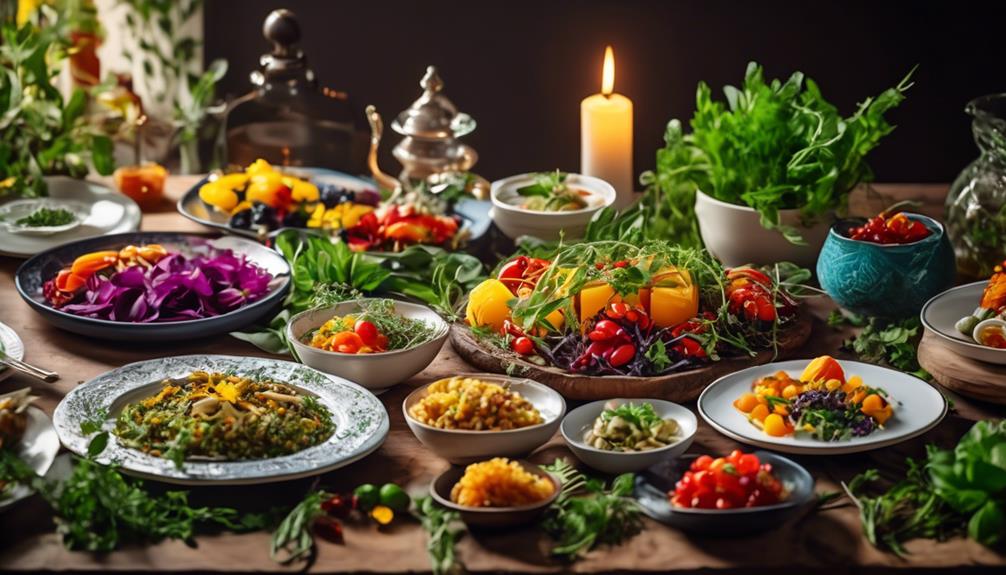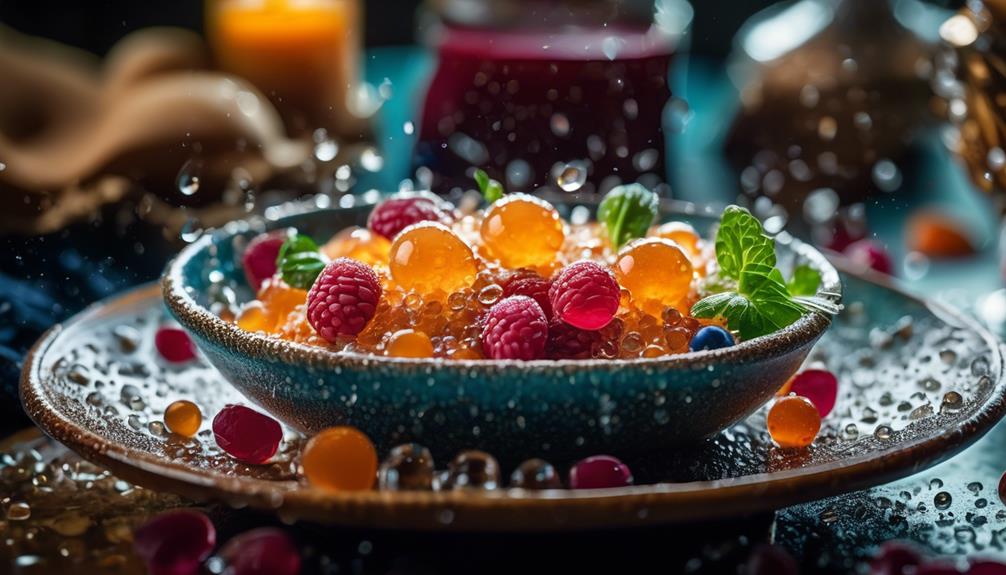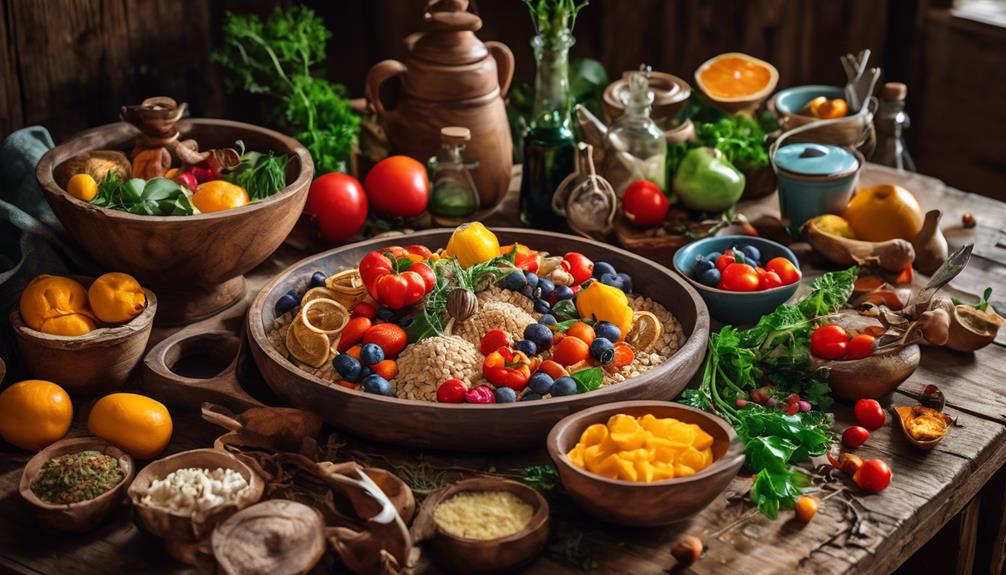Please note this post may contain affiliate links picked by me (Jay) that I have deemed may be of interest or relevant to you the reader of this.
These links do not affect the cost of the thing if you decide to purchase but i may get a little money if you choose to purchase.
For more information on my affiliate link policy click here.
As I sift through the digital archives of my mind, I can't help but marvel at the evolution of food and product photography. It's like watching an old sepia-toned film transform into a vibrant, high-definition masterpiece.
The techniques and ideas that have emerged over the years are nothing short of inspiring, and I am thrilled to share some of them with you. From capturing the raw beauty of ingredients to incorporating props for added visual interest, these seven ideas will surely leave you hungry for more.
So, grab your camera and prepare to embark on a visual feast that will tantalize your senses and ignite your creativity.
Key Takeaways
- Food styling is a meticulous art that transforms simple ingredients into works of art through arrangement and macro photography.
- Creative composition techniques, such as using unique props and backgrounds, elevate ordinary images to extraordinary works of art.
- Natural lighting enhances images by adding depth, dimension, and highlighting features and textures.
- Styling tips, including presentation techniques, choosing the right backdrop, and using props, enhance visual appeal and create a narrative in food and product photography.
Capturing the Beauty of Ingredients
When photographing food and products, one of the most captivating aspects is capturing the sheer beauty of the ingredients themselves. As a food stylist and photographer, I've always been fascinated by the intricate details and vibrant colors that ingredients possess. Through the lens of my camera, I'm able to bring these elements to life, creating visually stunning images that evoke a sense of desire and innovation.
Food styling plays a crucial role in showcasing the beauty of ingredients. By carefully arranging and presenting the food, I can highlight its natural textures, colors, and shapes. Whether it's arranging a plate of fresh fruits or layering the ingredients of a delectable dessert, every element is meticulously placed to create a visually enticing composition. The art of food styling allows me to transform simple ingredients into works of art.
Macro photography is another technique that I often employ to capture the intricate details of ingredients. By using a macro lens, I can zoom in on the smallest details, revealing the textures and patterns that are often overlooked by the naked eye. From the delicate veins of a leaf to the intricate patterns on a strawberry, macro photography allows me to showcase the beauty that lies within the ingredients.
Creative Composition Techniques
As I continue to explore the captivating beauty of ingredients in food and product photography, my focus now shifts to the realm of creative composition techniques. Capturing stunning images goes beyond just the subject itself; it involves the careful arrangement of unique props and creative backgrounds. These elements can elevate a photograph from ordinary to extraordinary, adding depth, interest, and a touch of innovation.
To engage the audience and enhance visual storytelling, incorporating unique props is essential. These props can range from vintage silverware to colorful linens, from fresh herbs to rustic wooden boards. By carefully selecting and positioning these props, I can create a narrative that speaks to the audience, evoking emotions and telling a story through the image.
Similarly, creative backgrounds play a crucial role in composition. They provide a backdrop that complements the subject and adds visual interest. Experimenting with different textures, colors, and patterns can create a dynamic contrast and make the subject pop. Whether it's a weathered tabletop, marble countertop, or a vibrant fabric, the background should enhance the overall composition and reinforce the desired mood.
To demonstrate the significance of unique props and creative backgrounds, here is a table showcasing some examples:
| Unique Props | Creative Backgrounds |
|---|---|
| Vintage silverware | Weathered wooden tabletop |
| Colorful linens | Marble countertop |
| Fresh herbs | Vibrant fabric |
Using Natural Lighting to Enhance Images
How can natural lighting be utilized to transform ordinary images into extraordinary works of art?
One of the most effective techniques is using reflectors to achieve balanced lighting. Reflectors bounce natural light onto the subject, reducing harsh shadows and creating a more even and flattering illumination. By strategically placing reflectors in the right positions, you can manipulate the light to highlight certain features or create interesting textures and patterns. This technique adds depth and dimension to your images, making them more visually appealing.
Another way to enhance your images using natural lighting is by shooting during the golden hour. The golden hour refers to the period shortly after sunrise or before sunset when the light is softer and warmer. This lighting condition creates a magical and ethereal atmosphere, with a golden glow that adds a touch of warmth and romance to your photos. The warm tones can enhance the colors of your subjects, making them appear more vibrant and inviting.
Styling Tips for Food and Product Photography
To create stunning and mouthwatering images in food and product photography, I employ a variety of styling techniques that capture the essence and allure of the subject. Here are some of the styling tips I use to take my images to the next level:
- Presentation techniques:
Presentation plays a crucial role in food and product photography. I carefully arrange the elements, paying attention to the colors, textures, and shapes. I use garnishes, props, and utensils to enhance the visual appeal and create a sense of depth and dimension.
- Choosing the right backdrop:
The backdrop sets the tone and mood for the photograph. I experiment with different materials like wood, marble, fabric, and metal to create interesting textures and contrasts. I also consider the color palette of the subject and choose a backdrop that complements it.
- Lighting and shadows:
Proper lighting is essential in food and product photography. I play with natural and artificial light sources to create highlights and shadows that add depth and dimension to the image. I use diffusers, reflectors, and bounce cards to control the direction and intensity of the light.
- Styling props:
Props can enhance the story and context of the subject. I carefully select props that complement the food or product, adding visual interest and creating a narrative. From vintage plates to colorful napkins, each prop is chosen with intention to create a cohesive and visually appealing composition.
Exploring Different Angles and Perspectives
With the foundation of styling techniques in place, I now turn my attention to exploring different angles and perspectives to bring a fresh and captivating dimension to my food and product photography. One of the ways I achieve this is by using unique framing techniques. Instead of always shooting from eye level, I experiment with shooting from above or below, capturing the subject from different vantage points. This allows me to showcase the food or product in a way that's unexpected and visually appealing.
Another technique I employ is incorporating artistic reflections into my photographs. By positioning reflective surfaces strategically, such as mirrors or glass, I can create interesting reflections that add depth and interest to the image. These reflections not only add a touch of elegance but also create a sense of intrigue, drawing the viewer's eye to different elements within the photograph.
Additionally, I experiment with different angles to highlight specific details or create a sense of movement. For example, I might shoot a beverage from a low angle to emphasize the bubbles rising to the surface, or capture a close-up of a slice of cake from a side angle to showcase its intricate layers.
Incorporating Props for Added Visual Interest
I love incorporating props into my food and product photography as they add an extra layer of visual interest, enhancing the overall aesthetic and story behind the image. Props have the power to transform a simple shot into a captivating scene that tells a compelling story.
Here are four ways I use props to create stunning visuals:
- Prop selection: Choosing the right props is crucial to create a cohesive and visually appealing composition. I carefully consider the colors, textures, and shapes of the props to complement the subject and evoke the desired mood.
- Creating a narrative: Props can help establish a narrative and bring the image to life. Whether it's a vintage teacup next to a slice of cake or a stack of books alongside a pair of glasses, props can tell a story and engage the viewer's imagination.
- Adding depth and dimension: Props can add depth and dimension to a photograph by creating layers. A strategically placed cutting board or a scattering of fresh herbs can create visual interest and make the image more dynamic.
- Enhancing the theme: Props can reinforce the theme or concept behind the photograph. For example, using rustic props like wooden utensils and burlap napkins can enhance a farm-to-table theme, while incorporating vibrant props like colorful fruits and flowers can evoke a sense of freshness and vitality.
Experimenting With Color and Texture
As I continue to explore the art of food and product photography, one area that consistently captivates me is the endless possibilities of experimenting with color and texture. It's amazing how a simple change in color or texture can completely transform the mood and tone of an image. From vibrant and bold colors to soft and muted tones, there's so much room for creativity and innovation.
One technique I love to explore when experimenting with color is playing with shadows. By strategically placing objects or using different lighting techniques, I can create interesting and dynamic shadows that add depth and dimension to my photographs. Shadows can enhance the texture of the subject and create a sense of drama and intrigue.
Another technique that I find fascinating is utilizing negative space. This involves intentionally leaving empty or blank spaces in the frame, allowing the subject to stand out and become the focal point. Negative space can create a sense of minimalism and simplicity, while also emphasizing the colors and textures of the subject.
Frequently Asked Questions
What Are Some Common Mistakes to Avoid When Capturing the Beauty of Ingredients in Food and Product Photography?
When capturing the beauty of ingredients in food and product photography, it's important to avoid some common mistakes.
One mistake is using artificial lighting that can make the colors look unnatural. Instead, try to utilize natural lighting effectively to enhance the quality of your images.
Another mistake to avoid is cluttering the frame with too many props or distractions. Keep it simple and focus on the ingredients themselves.
How Can I Create a Visually Appealing Composition Using Unique and Creative Techniques?
Creating a visually appealing composition in food and product photography is all about letting your creativity shine. By experimenting with unique and creative techniques, you can elevate your images to a whole new level.
From innovative food styling to playing with unique lighting techniques, the possibilities are endless. By pushing boundaries and thinking outside the box, you can create captivating and awe-inspiring photographs that will leave your audience craving for more.
Don't be afraid to take risks and let your imagination run wild!
What Are Some Tips for Utilizing Natural Lighting Effectively to Enhance the Quality of Food and Product Images?
When it comes to enhancing the quality of food and product images, utilizing natural lighting effectively is key.
Natural light has a way of bringing out the true colors and textures of the subject, making it appear more vibrant and appealing.
By positioning your subject near a window or shooting outside during the golden hour, you can create stunning images with soft, diffused lighting that adds depth and dimension.
Don't underestimate the power of Mother Nature's lighting!
Are There Any Specific Styling Tips or Techniques That Can Help Me Achieve Professional-Looking Food and Product Photography?
When it comes to achieving professional-looking food and product photography, there are some specific styling tips and techniques that can make all the difference.
One key aspect is the selection of props and backgrounds. By carefully choosing props that complement the subject and using backgrounds that enhance the overall aesthetic, you can create visually appealing images.
Additionally, incorporating color and texture in your food and product styling adds depth and interest. These elements help to create innovative and captivating visuals that will inspire your audience.
Can You Provide Some Examples of How Different Angles and Perspectives Can Create More Dynamic and Interesting Food and Product Photos?
Different angles and perspectives can truly transform food and product photography, making it more dynamic and captivating. By experimenting with unique angles, like shooting from above or at eye level, you can create a sense of depth and dimension.
Incorporating different lighting techniques adds drama and highlights textures. Creative props and backgrounds can also enhance the overall composition and storytelling.
These techniques allow for endless possibilities, inspiring innovation and pushing the boundaries of food and product photography.
Conclusion
In the vibrant world of food and product photography, the possibilities are endless. By capturing the beauty of ingredients, experimenting with composition techniques, and utilizing natural lighting, you can create stunning images that captivate your audience.
Don't be afraid to explore different angles and perspectives, incorporate props for added visual interest, and play with color and texture.
With these inspiring ideas in mind, your photography will reach new heights of creativity and sophistication.
So grab your camera, unleash your imagination, and let your creativity shine!


